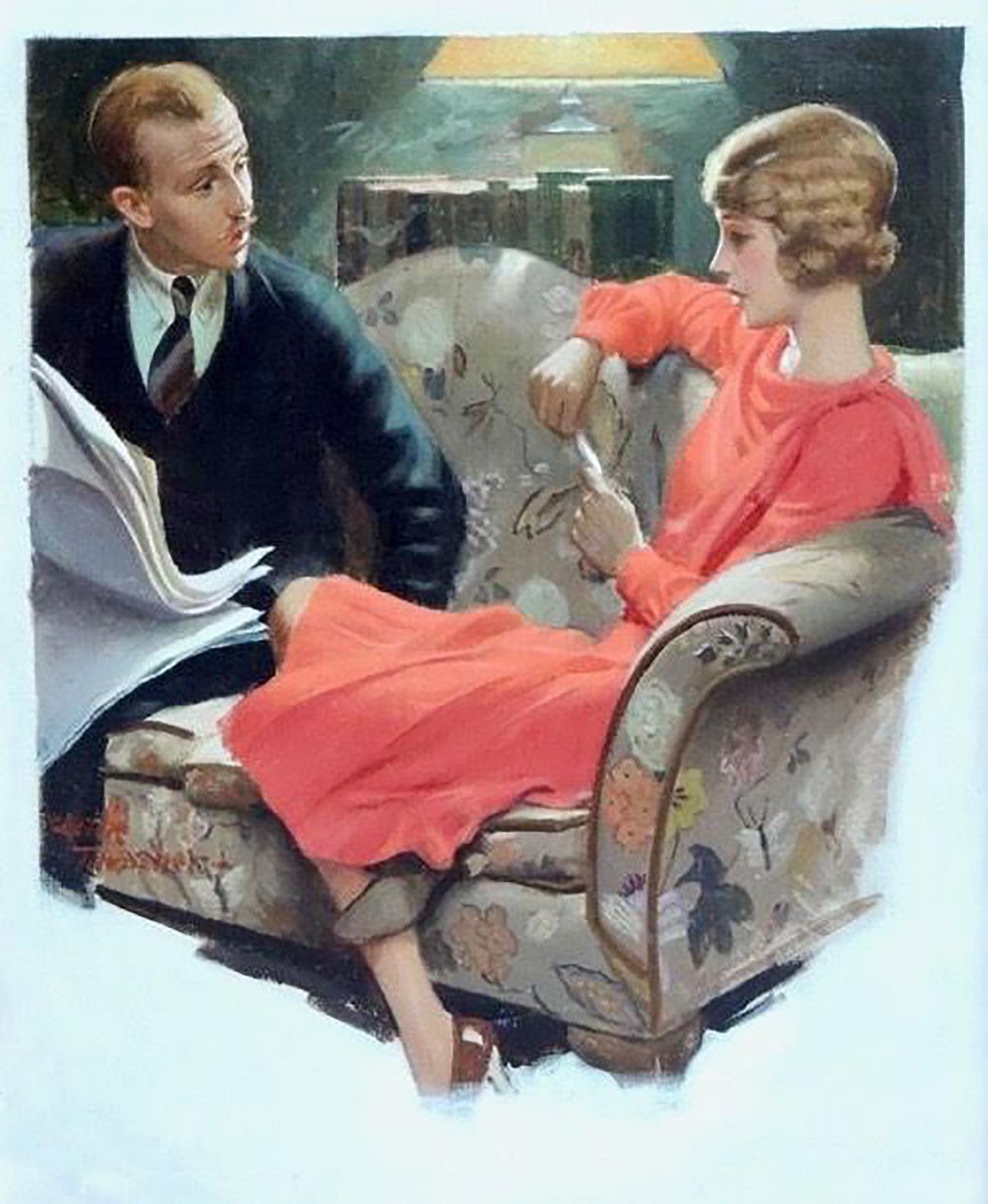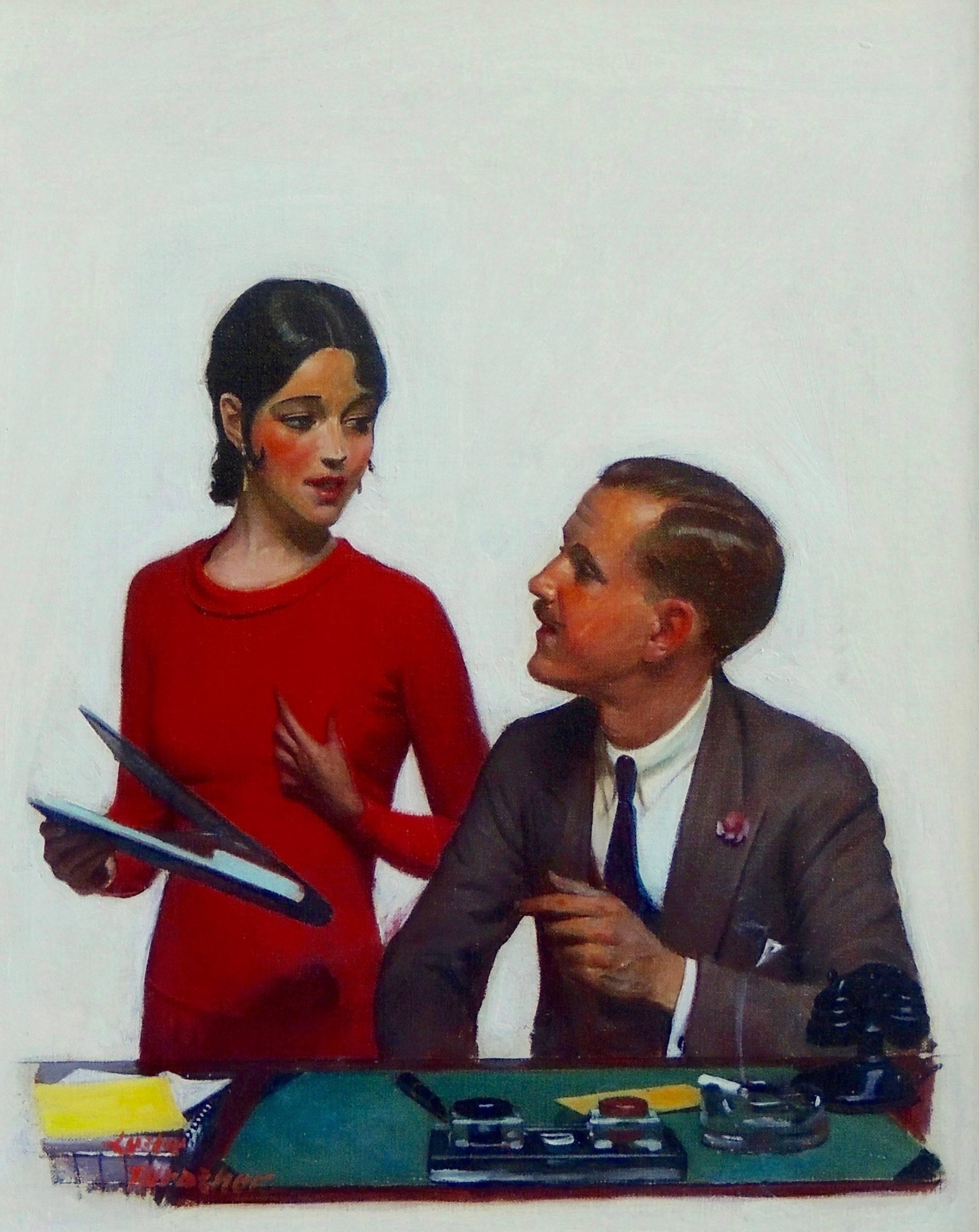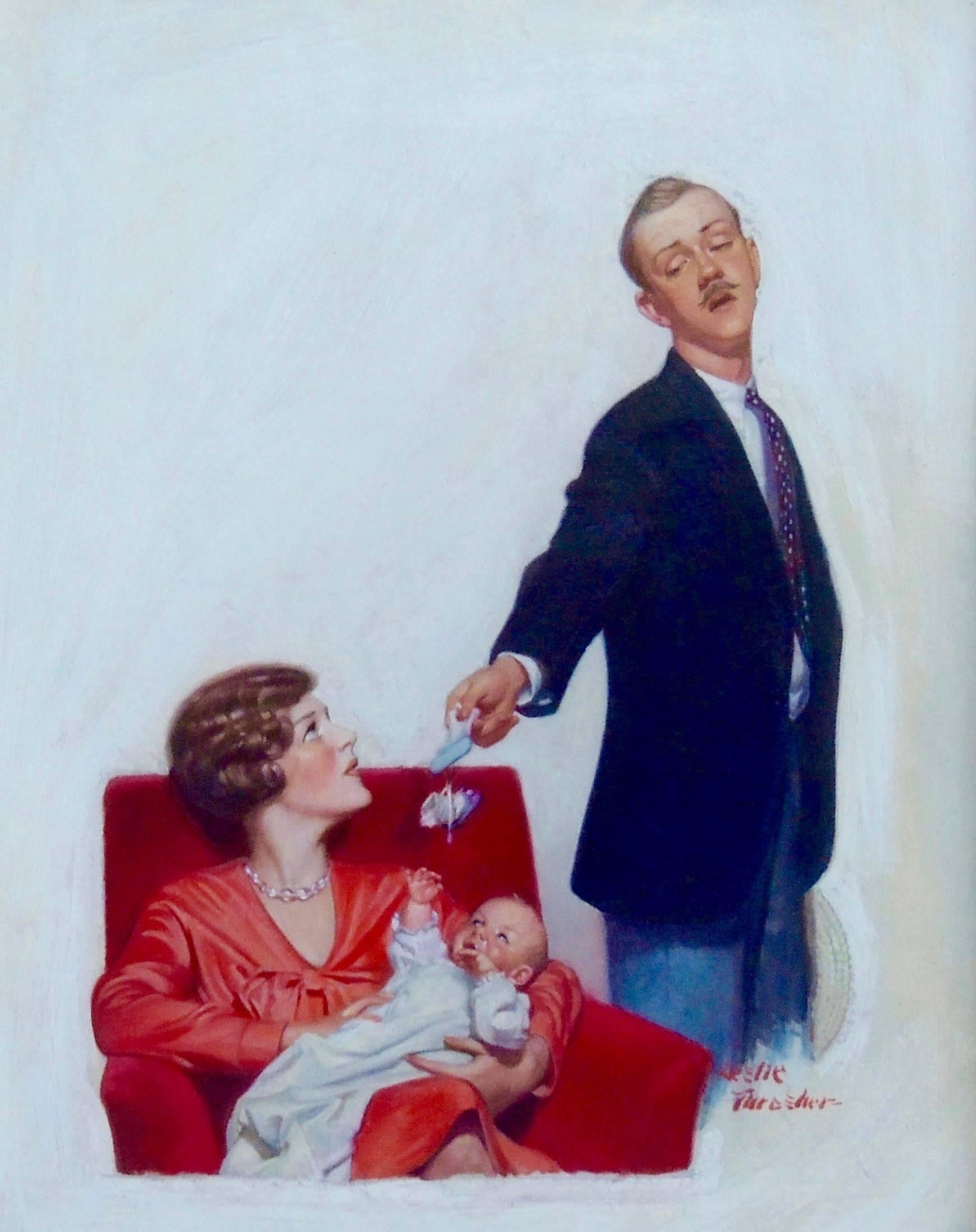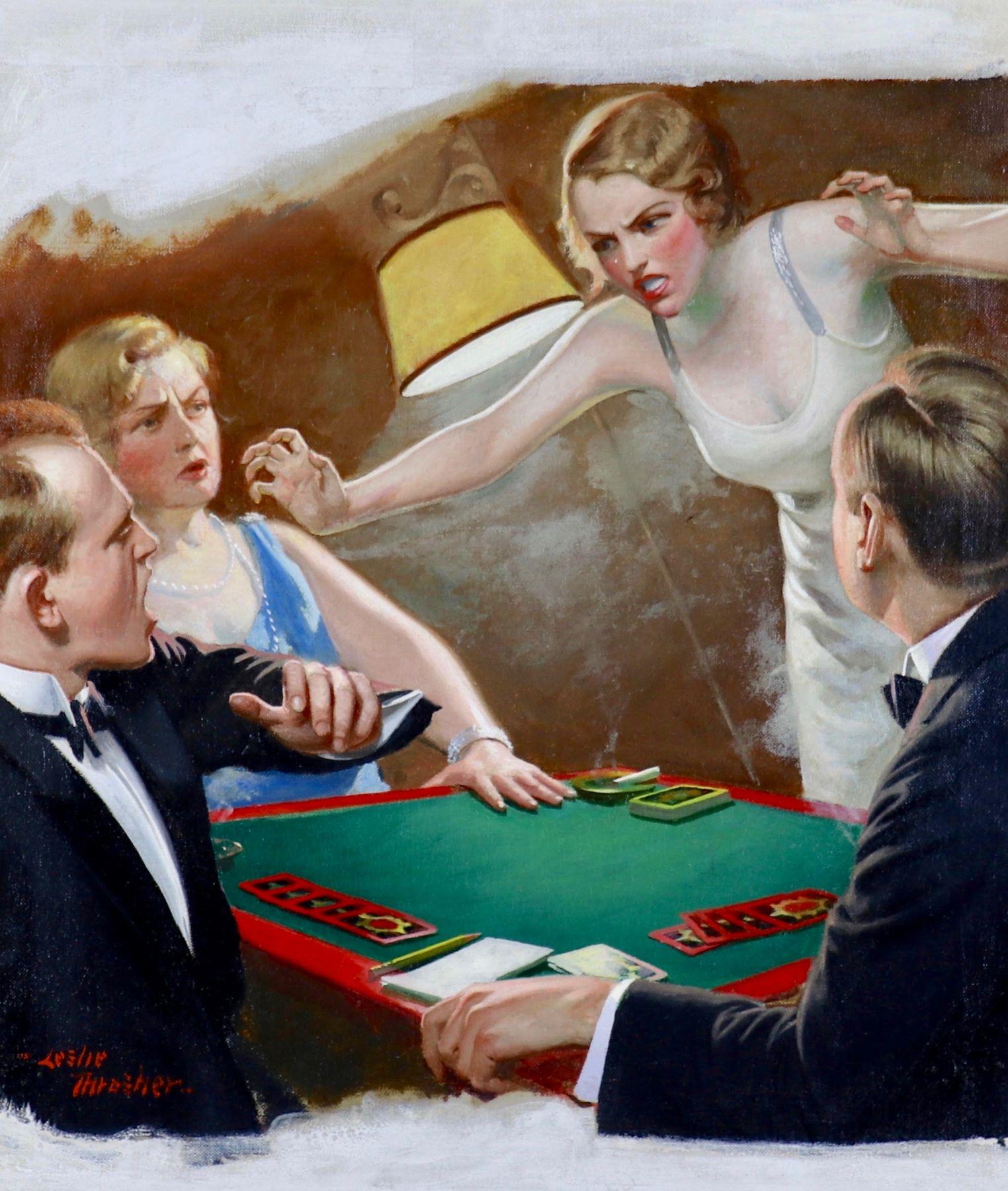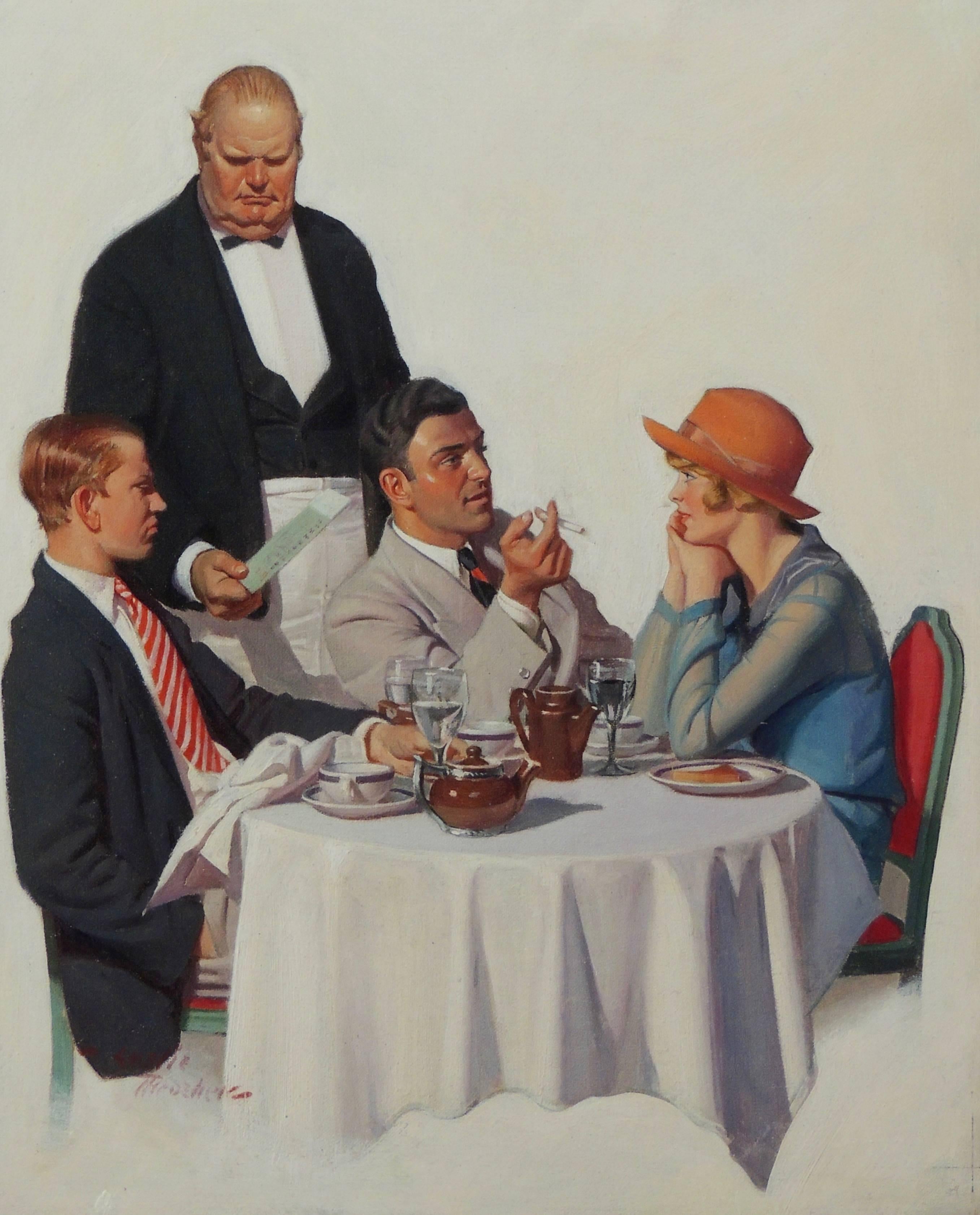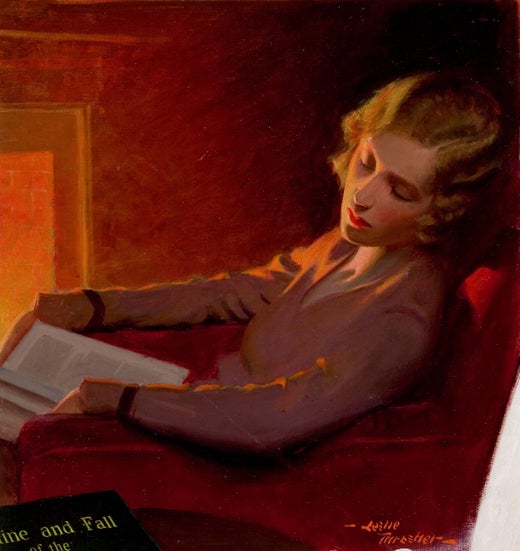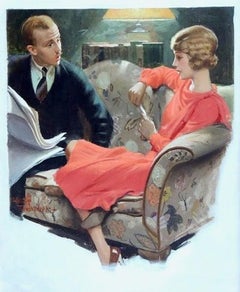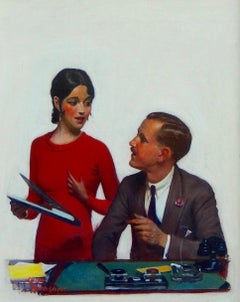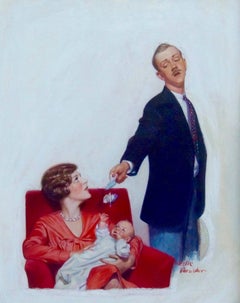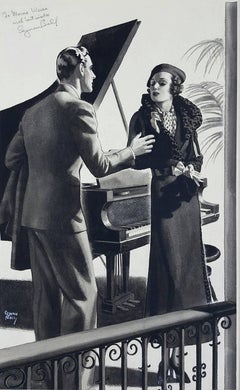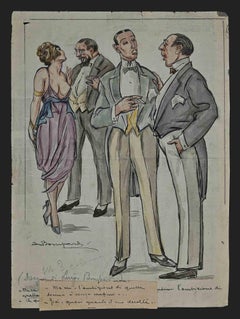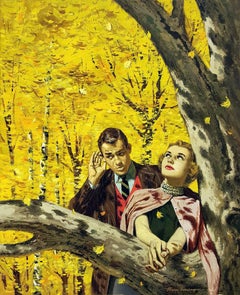Items Similar to No, I can never be Mrs. Hammerschlosser!, Liberty Magazine Cover January 22, 192
Want more images or videos?
Request additional images or videos from the seller
1 of 8
Leslie ThrasherNo, I can never be Mrs. Hammerschlosser!, Liberty Magazine Cover January 22, 1921927
1927
$13,500
£10,157.50
€11,732.12
CA$19,079.02
A$20,703.65
CHF 10,971.11
MX$253,920.18
NOK 135,766.69
SEK 128,292.34
DKK 87,586.15
About the Item
Original cover for Liberty magazine, published January 22, 1927.
Blissful in her recent engagement to Sandy, Lil spends an evening at home knitting him a pair of green zigzag sport hose. Lil’s kid brother, Junior, briefly disrupts the serenity of the scene by rushing into the room with his dog, asking who she was expecting to come by this evening. After hearing that Mr Hammerschlosser, the aging and wealthy widower, was on his way, Junior bolts from the room. Lil hides Sandy’s socks under a couch pillow as she hears Mr. Hammerschlosser kick the snow off his boots on the front porch before ringing the bell.
Beaming over a bouquet of red roses, Mr. Hammerschlosser makes himself comfortable in Pop’s chair as he tells her how much he missed her on his recent travels. Eventually, Mr. Hammerschlosser pulls out a purple velvet box from his pocket and sinks to his knees as he asks Lil to marry him. Lil looks at the pearls in the box and rises abruptly, and dramatically exclaims, “No, I can never be Mrs. Hammerschlosser!” (Liberty magazine, January 22, 1927, p. 69)
“For the Love o’ Lil: The Picture Story of an American Family”
In 1926, under his long-term contract to produce a cover per week for Liberty magazine, Leslie Thrasher introduced a signature cast of characters that appeared each week, telling a serialized story through his illustrations. Liberty touted its new cover serial as “something no magazine has ever done before…Heretofore, all magazine covers have been disconnected pictures.” To help readers follow the plot from week to week, a short story summary was printed in each issue. (Liberty magazine, June 19, 1926, pp. 69-70).
“For the Love o’ Lil” centers around the lives of Lil Morse and Sandy Jenkins and includes recurring characters from their extended family and social circles. The serial follows the couples’ adventures through courtship, the ups and downs of married life, the antics of their offspring with the neighborhood children, and the complex dynamics of relationships with in-laws. The goal was to show a typical modern American family whose eccentricities and foibles would attract readers each week. Thrasher used himself as the model for Lil’s father, Robert E. Lee Morse.
Liberty further engaged readers by running contests for best titles, and later, for suggested storylines. The model proved successful and “For the Love o’ Lil” became a popular hallmark of the publication for many years, resulting in a 1930 film adaptation starring the flapper Sally Starr.
Leslie Thrasher
Leslie Thrasher first began contributing covers to Liberty in 1924, and in 1926 he was offered a contract to create a cover per week at the rate of $1,000 per week. Going against the advice of his friend Norman Rockwell, Thrasher accepted the contract, agreeing to complete a weekly cover for six years - an immensely challenging endeavor requiring that both new ideas and new artwork be produced at an extremely rapid pace. The continuing storyline of the cover serial “For the Love o’ Lil” helped Thrasher keep up with the constant demand for new images.
Due to declining circulation, Liberty terminated Thrasher’s contract in 1932. A few years later in 1936, Thrasher died from pneumonia caused by smoke inhalation from a fire in his home, which also destroyed much of his original artwork. An incredibly prolific artist, Thrasher had created more than 360 covers in his lifetime for various publications, including 23 covers for The Saturday Evening Post.
Leslie Thrasher was born in Piedmont, West Virginia. He studied art at the Philadelphia Academy and at the age of 16, won a scholarship that allowed him to study in Paris. Upon his return to the United States, Thrasher studied with Howard Pyle in Wilmington, Delaware and briefly worked as a portrait painter before moving to New York City to begin his commercial career producing illustration for magazines and advertising agencies. Thrasher also served in World War I, where he was assigned work as a camouflage painter.
Date: 1927
Medium: Oil on Canvas
Sight Size 20.00" x 16.00;" Framed 26.00" x 22.00"
Signature: Signed Lower Right
- Creator:Leslie Thrasher (1889 - 1936, American)
- Creation Year:1927
- Dimensions:Height: 20 in (50.8 cm)Width: 16 in (40.64 cm)
- Medium:
- Period:
- Condition:
- Gallery Location:Fort Washington, PA
- Reference Number:Seller: 31701stDibs: LU38432007933
Leslie Thrasher
Leslie Thrasher first began contributing covers to Liberty in 1924, and in 1926 he was offered a contract to create a cover per week at the rate of $1,000 per week. Going against the advice of his friend Norman Rockwell, Thrasher accepted the contract, agreeing to complete a weekly cover for six years - an immensely challenging endeavor requiring that both new ideas and new artwork be produced at an extremely rapid pace. The continuing storyline of the cover serial “For the Love o’ Lil” helped Thrasher keep up with the constant demand for new images. Due to declining circulation, Liberty terminated Thrasher’s contract in 1932. A few years later in 1936, Thrasher died from pneumonia caused by smoke inhalation from a fire in his home, which also destroyed much of his original artwork. An incredibly prolific artist, Thrasher had created more than 360 covers in his lifetime for various publications, including 23 covers for The Saturday Evening Post. Leslie Thrasher was born in Piedmont, West Virginia. He studied art at the Philadelphia Academy and at the age of 16, won a scholarship that allowed him to study in Paris. Upon his return to the United States, Thrasher studied with Howard Pyle in Wilmington, Delaware and briefly worked as a portrait painter before moving to New York City to begin his commercial career producing illustration for magazines and advertising agencies. Thrasher also served in World War I, where he was assigned work as a camouflage painter.
About the Seller
5.0
Recognized Seller
These prestigious sellers are industry leaders and represent the highest echelon for item quality and design.
Platinum Seller
Premium sellers with a 4.7+ rating and 24-hour response times
Established in 1995
1stDibs seller since 2016
135 sales on 1stDibs
Typical response time: 1 hour
- ShippingRetrieving quote...Shipping from: Fort Washington, PA
- Return Policy
Authenticity Guarantee
In the unlikely event there’s an issue with an item’s authenticity, contact us within 1 year for a full refund. DetailsMoney-Back Guarantee
If your item is not as described, is damaged in transit, or does not arrive, contact us within 7 days for a full refund. Details24-Hour Cancellation
You have a 24-hour grace period in which to reconsider your purchase, with no questions asked.Vetted Professional Sellers
Our world-class sellers must adhere to strict standards for service and quality, maintaining the integrity of our listings.Price-Match Guarantee
If you find that a seller listed the same item for a lower price elsewhere, we’ll match it.Trusted Global Delivery
Our best-in-class carrier network provides specialized shipping options worldwide, including custom delivery.More From This Seller
View AllW-w-whats Zat, Liberty Magazine Cover, 1929
By Leslie Thrasher
Located in Fort Washington, PA
Original cover for Liberty magazine, published December 14, 1929.
As Sandy and Lil retire to the sofa after dinner, Lil comments on how quiet Sandy has been after returning from hi...
Category
20th Century Figurative Paintings
Materials
Canvas, Oil
"I'd Love To, " Liberty Magazine Cover, 1929
By Leslie Thrasher
Located in Fort Washington, PA
Original cover for Liberty magazine, published November 2, 1929.
Sandy hides behind the newspaper at the breakfast table as Lil suddenly asks “Who is Marianthe? You talked about her...
Category
1920s Figurative Paintings
Materials
Canvas, Oil
Fare Thee Well! Liberty Magazine Cover
By Leslie Thrasher
Located in Fort Washington, PA
Original cover for Liberty magazine, published August 4, 1928.
Having left her husband Sandy, Lil returns to the Morse family home with her two-month-old baby. Ma Morse worries abou...
Category
1920s Figurative Paintings
Materials
Canvas, Oil
You Go There Yourself!, Liberty Magazine Cover
By Leslie Thrasher
Located in Fort Washington, PA
“For the Love o’ Lil: The Picture Story of an American Family”
In 1926, under his long-term contract to produce a cover per week for Liberty magazine, Leslie Thrasher introduced a s...
Category
1920s Figurative Paintings
Materials
Canvas, Oil
'You Moron', Liberty Magazine Cover
By Leslie Thrasher
Located in Fort Washington, PA
Original cover for Liberty magazine, published May 23, 1931.
Lil and Sandy have their friends Mr. and Mrs. Saunders Shanks over to their house for a game of cards. After settling do...
Category
1930s Figurative Paintings
Materials
Canvas, Oil
The Bad News, Liberty Magazine Cover, Oct. 2, 1926
By Leslie Thrasher
Located in Fort Washington, PA
Original cover for Liberty magazine, published October 2, 1926
Sandy glowers as he sits at the table watching his rival Babe Dolan, the athletic lifeguard, flirt with Lil. Lil is entranced as Babe promises to make her a champion swimmer and the two are oblivious to the arrival of the waiter with the check, which Sandy reluctantly pays with nearly all of the remaining money in his wallet. (Liberty magazine, October 2, 1926, p. 54)
This cover illustration was produced right after Liberty ceased their title contest for readers.
“For the Love o’ Lil: The Picture Story of an American Family”
In 1926, under his long-term contract to produce a cover per week for Liberty magazine, Leslie Thrasher introduced a signature cast of characters that appeared each week, telling a serialized story through his illustrations. Liberty touted its new cover serial as “something no magazine has ever done before…Heretofore, all magazine cover...
Category
1920s Figurative Paintings
Materials
Canvas, Oil
You May Also Like
Art Deco Coulple Magazine Story Illustration, RedBook The Saturday Evening Post
By Seymour Alling Ball
Located in Miami, FL
Signed lower left: Seymour Ball Inscribed upper left: To Morris E Weiss with best wishes Seymour Ball" Matted not framed
Category
1930s Art Deco Figurative Drawings and Watercolors
Materials
India Ink, Watercolor, Illustration Board
Elite Discourse - Drawing by Luigi Bompard - 1920s
Located in Roma, IT
Elite Discourse is a watercolor and ink drawing on ivory-colored paper, in the 1920s realized by Luigi Bompard (1879-1953).
Hand-signed in pen on the lower margin.
In good conditio...
Category
1920s Art Deco Figurative Drawings and Watercolors
Materials
Ink, Watercolor
Love Story, Illustration for the Saturday Evening Post
By Bruce Bomberger
Located in Miami, FL
An illustrator for Time, Life, Look, True, True West, Saturday Evening Post, Good Housekeeping, Readers Digest, and others, he also painted for adverti...
Category
1950s American Realist Figurative Paintings
Materials
Gouache
Love Story, Illustration for the Saturday Evening Post
By Bruce Bomberger
Located in Miami, FL
An illustrator for Time, Life, Look, True, True West, Saturday Evening Post, Good Housekeeping, Readers Digest, and others, he also painted for adverti...
Category
1950s American Realist Figurative Paintings
Materials
Gouache
Life Magazine Satirical Society Cartoon Illustration
Located in Wilton Manors, FL
Barbara Shermund (1899-1978). Society Satirical Cartoon, ca. 1940s. Gouache on heavy illustration paper, image measures 17 x 14 inches; 23 x 20 inches in matting. Signed lower left. Very good condition but matting panel should be replaced. Unframed.
Provenance: Ethel Maud Mott Herman, artist (1883-1984), West Orange NJ.
For two decades, she drew almost 600 cartoons for The New Yorker with female characters that commented on life with wit, intelligence and irony.
In the mid-1920s, Harold Ross, the founder of a new magazine called The New Yorker, was looking for cartoonists who could create sardonic, highbrow illustrations accompanied by witty captions that would function as social critiques.
He found that talent in Barbara Shermund.
For about two decades, until the 1940s, Shermund helped Ross and his first art editor, Rea Irvin, realize their vision by contributing almost 600 cartoons and sassy captions with a fresh, feminist voice.
Her cartoons commented on life with wit, intelligence and irony, using female characters who critiqued the patriarchy and celebrated speakeasies, cafes, spunky women and leisure. They spoke directly to flapper women of the era who defied convention with a new sense of political, social and economic independence.
“Shermund’s women spoke their minds about sex, marriage and society; smoked cigarettes and drank; and poked fun at everything in an era when it was not common to see young women doing so,” Caitlin A. McGurk wrote in 2020 for the Art Students League.
In one Shermund cartoon, published in The New Yorker in 1928, two forlorn women sit and chat on couches. “Yeah,” one says, “I guess the best thing to do is to just get married and forget about love.”
“While for many, the idea of a New Yorker cartoon conjures a highbrow, dry non sequitur — often more alienating than familiar — Shermund’s cartoons are the antithesis,” wrote McGurk, who is an associate curator and assistant professor at Ohio State University’s Billy Ireland Cartoon Library & Museum. “They are about human nature, relationships, youth and age.” (McGurk is writing a book about Shermund.
And yet by the 1940s and ’50s, as America’s postwar focus shifted to domestic life, Shermund’s feminist voice and cool critique of society fell out of vogue. Her last cartoon appeared in The New Yorker in 1944, and much of her life and career after that remains unclear. No major newspaper wrote about her death in 1978 — The New York Times was on strike then, along with The Daily News and The New York Post — and her ashes sat in a New Jersey funeral...
Category
1940s Realist Figurative Paintings
Materials
Gouache
William Fisher Classic American Illustration on Canvas
Located in New York, NY
William Fisher (American, 1891-1985)
Untitled, 20th Century
Oil on canvas/illustration
23 3/4 x 29 3/4 in.
Framed: 31 x 37 1/4 x 1 in.
Signed lower right: William Fisher
William Fis...
Category
20th Century American Modern Figurative Paintings
Materials
Canvas, Oil
